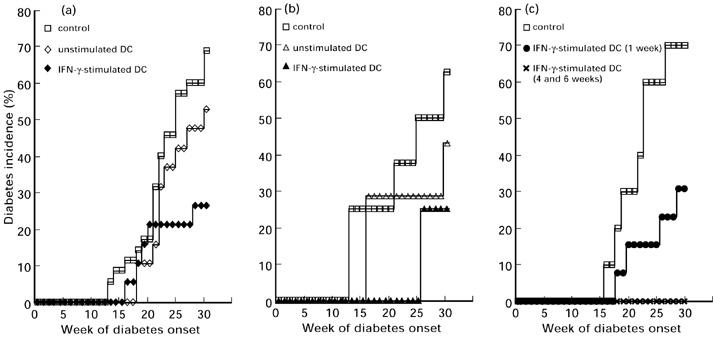Fig. 1.

Prevention of diabetes onset by transfer of IFN-γ-stimulated DC. (a) DC purified from the spleen of NOD mice were stimulated with or without IFN-γ for 24 h and intraperitoneally transferred into 4-week-old NOD mice. Survival curve analysis of diabetes incidence using the log rank test was performed to analyse the data statistically. Control NOD mice developed diabetes in 24 of 35 recipients (68.6%) by the age of 30 weeks. NOD mice given IFN-γ-stimulated DC developed diabetes in five of 19 recipients (26.3%), and the reduction of the incidence was statistically significant (P < 0.01). Ten of 19 (52.6%) NOD mice given unstimulated DC developed diabetes; this was not significant. (b) DC purified from the spleen of ICR mice were stimulated with or without IFN-γ for 24 h and intraperitoneally transferred into 4-week-old NOD mice. Diabetes incidence of NOD mice given IFN-γ-stimulated DC was 2/8 (25.0%) (P < 0.05), and that of NOD mice given unstimulated DC was 3/7 (42.8%) (NS). (c) DC purified from the spleens of NOD mice were stimulated with IFN-γ for 24 h and intraperitoneally transferred into NOD mice once at 1 week old, or twice at 4 and 6 weeks old. The incidence of diabetes of NOD mice given IFN-γ-stimulated DC at 1 week old was 4/13 (30.8%) (P < 0.05), and that of NOD mice treated twice at 4 and 6 weeks old was 0/6 (0%) (P < 0.01).
